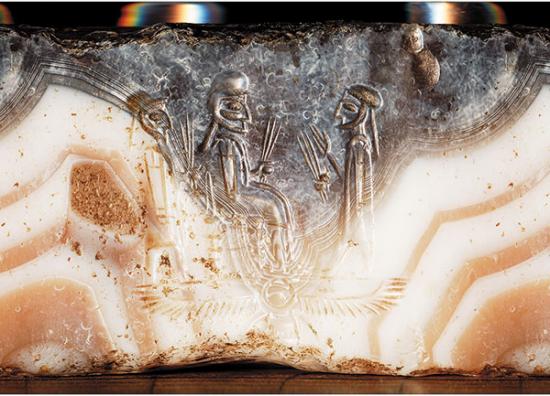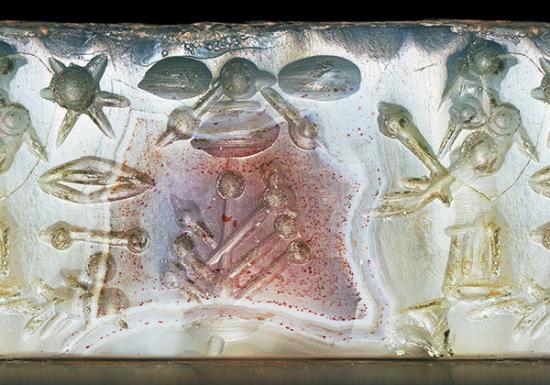A new look at Mesopotamia’s smallest art form
Noah Wiener
Source - http://www.biblicalarchaeology.org/daily/ancient-cultures/ancient-near-eastern-world/cylinder-seals-a-better-impression/

The fiery wings of the sun disc of the Persian deity Ahura-Mazda would not be visible in traditional seal publications, which show rolled impressions instead of the seal itself. In this 360-degree photo, we see that the artist used the natural brown and white banded waves on this agate stone to create an image of the sun’s rays at dawn, resulting in an unusual impression of the sun-disc below the three magi, rather than above. Photo: Wayne T. Pitard
Archaeologists that have worked in the Near East will tell you that pottery sherds form a significant percentage of their finds, so keeping track of all that pottery must have been pretty important to the Mesopotamians. But how did they know whose was whose? They signed them—but not like we do today.
The tools Mesopotamians used to create these “signatures” were actually a beautiful art form–tiny cylinder seals carved with ornate decorations. As Wayne T. Pitard explains in the article “Circular Signatures” in the May/June 2014 issue of Biblical Archaeology Review, “Since very few people could actually write, someone came up with the idea of creating a small cylinder carved with an intricate design that could be rolled across the face of a damp tablet, leaving a mirror image of the design impressed on the clay. The impression could be identified with the person responsible (or at least the office the person held) and thus served essentially as our signatures do today. As time went on, the popularity of cylinder seals spread from governmental officials to the wider public. Seals came to be used to authenticate contracts, wills, adoptions, letters, etc. Over the millennia thousands of seals were produced.”

The 360-degree camera at the Spurlock Museum. Photo: Wayne T. Pitard.
Pitard appreciates Mesopotamian cylinder seals as one of the finest art forms of the ancient world—sometimes less than an inch high, they were intricately designed and remained in use for some 3,000 years (c. 3400-400 B.C.E.). However, “despite their value as cultural artifacts, cylinder seals have been one of the least adequately published forms of ancient Near Eastern art … Perhaps most important, they have been very difficult to photograph.”
Since most photographs of cylinder seals only show a single angle, they miss a great deal of the decoration, which was generally carved across the entire 360-degree surface of a cylinder seal. As a result, scholars usually opt to publish photos of clay impressions made by the seals, rather than the seal itself.

The glowing tree on this Neo-Assyrian white agate seal is carved on a red patch of hematite, making the tree the focus of the scene. Photo: Wayne T. Pitard.
However, by not publishing the cylinder seal itself, we lose any information about how the artist worked with their material. Author Wayne T. Pitard worked with Bruce Zuckerman, Ken Zuckerman and Marilyn Lundberg Melzian to get a better look at cylinder seals. The images produced by their 360-degree cameras are not only stunning; they also provide new information about the cylinder seals themselves.
Take a look at the pictures of the Persian and Neo-Assyrian seals in this post, which were taken with the 360-degree camera. An impression of the Persian cylinder seal (at the top of this article) would show figures above a winged sun-disc and would miss the way the artist used the banded waves of the agate stone to create the sun’s rays at dawn. Likewise, in the Neo-Assyrian seal to the right, the artist used a red patch of hematite as a highlight for the sacred tree; this careful planning would be lost in a traditional impression.
———
For more on 360-degree cylinder seal photography and what it can teach us about this unique art form, read Wayne T. Pitard’s article “Circular Signatures” in the BAS Library as it appears in the May/June 2014 issue of Biblical Archaeology Review.